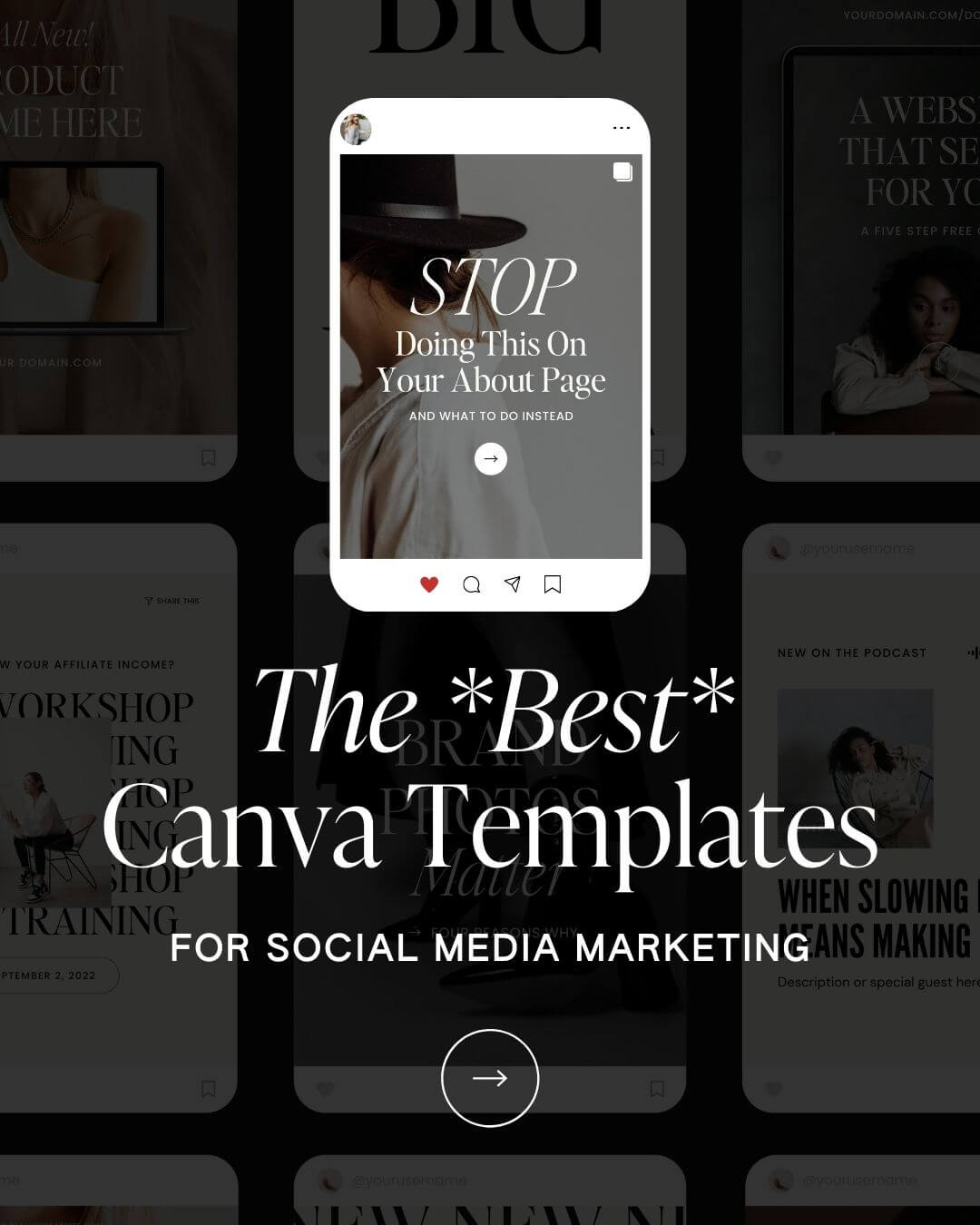BY MAGI FISHER | THE ARTISTS’ LAWYER
Client nitpicking your contract? Good! That means they care. Here’s how to communicate with them to move the conversation forward.
Picture this: you have a great discovery call, the client accepts your proposal without any comments about the price, and you send over the contract…
Only to get an email back with a list of questions, changes, and edits.
Cue: Panic.
You might be thinking, “Ugh, I don’t know how to explain these terms to them; what do I say?!” or maybe even, “Are they going to be this challenging to work with the whole time?”
Either way, you’re probably having a moment of insecurity — which is totally normal!
So, take a deep breath, put on your business owner hat, and keep reading.
Disclosure: All links in this post to The Artists’ Lawyer contracts are affiliate links. We only ever recommend products and services we fully believe in and Magi at The Artists’ Lawyer is one of them. We may receive commission through purchases you make with these links. Use code TONIC at checkout for 15% off!
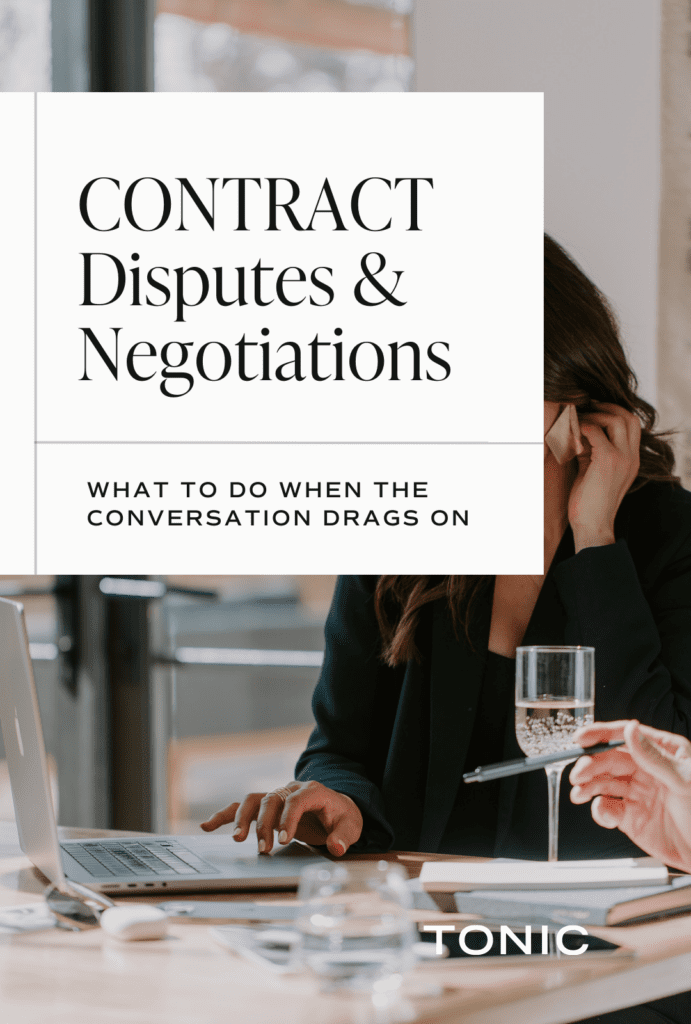
A Client Questioning Your Contract Isn’t Always A Bad Thing
It may seem counter-intuitive, but a client reading your contract closely is a good thing. This indicates they’re committed and thorough — which could mean they’ll be an engaged partner in your project, and provide detailed feedback which will make your job easier.
In the short term, it might feel safer if the client signs immediately, but this could raise questions later on. Termination discussions can get a little dicey if the client never read the terms of their agreement in the first place, so when they’re enforced later on during termination proceedings, they feel caught off guard.
A client reading through your whole contract and providing feedback lays the foundation for a collaborative relationship built on trust and communication.
So, How Do I Respond?
Responding to contract questions, entering negotiations, and even handling disputes is extremely situational. It depends on the client and how they communicate, and what’s transpired in the interaction so far. No two conversations are the same — but your contract usually is.
BEFORE THE PROJECT BEGINS →
If a potential client is asking questions or requesting changes to the contract before signing and starting work (like in the situation above!), respond professionally, clearly, and patiently. You both want the same outcome — to get the contract signed, and begin work! It’s just a matter of making sure everyone feels secure.
Start by validating their email. For example:
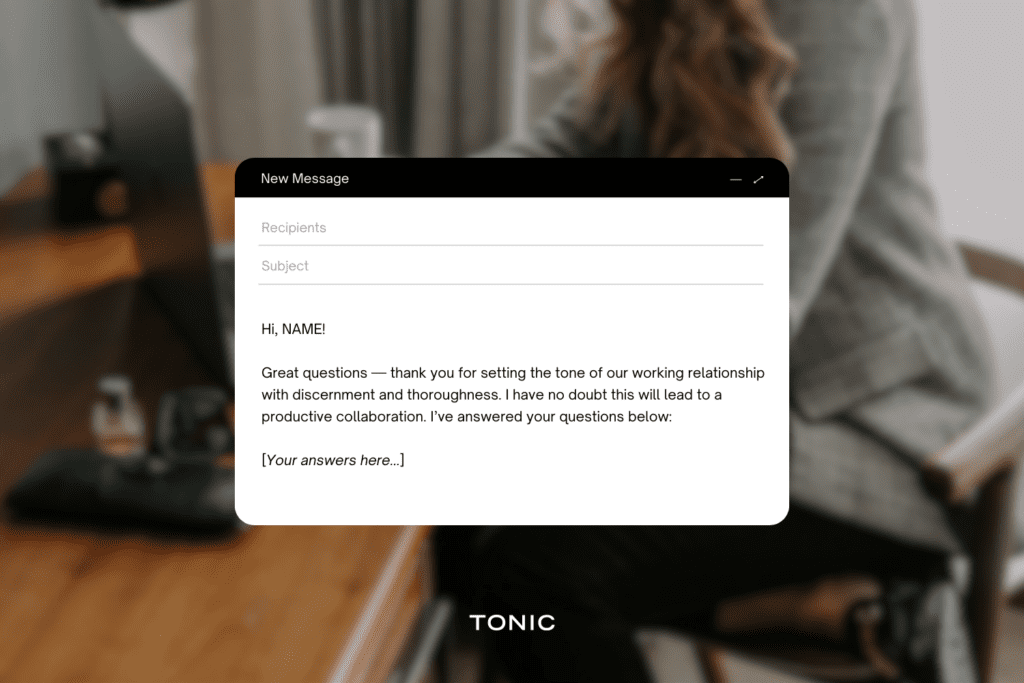
Sometimes their questions are focused on clarifying exactly what a clause says. In this case, you can simply answer using layman’s terms, and even give an example. I tend to have answers to the most common clarifying questions pre-written (with examples) and saved in a doc, so I can copy-paste when I need them. This might help you feel empowered (instead of stressed) when — not if — questions arise.
Other times, the client might request changes to the terms. It’s up to you whether or not you feel comfortable altering the terms of your agreement. If you purchase a contract template from The Artists’ Lawyer shop (use code TONIC at checkout for 15% off), I typically advise against changing any of the terms in the agreement. Each clause is in there for a reason and removing or altering any of them could put your business at risk. However, you might take some time to think about which clauses you’re firm on, and which you’re willing to be flexible on, or even modify — for example, extending dates for late payments. I try to document which clauses I am and am not willing to alter ahead of time, to make sure I am not crossing my own boundaries in the moment.
Finally, you might have a particularly savvy client who calls out inconsistencies, discrepancies or errors in your contract. If it’s something simple such as replacing their name with their company name, this shouldn’t be an issue. But if the integrity of your contract is in question, consult with an attorney to make sure both you and your client are protected.

DURING THE PROJECT →
Let’s say a client is expressing dissatisfaction during their project. Maybe they aren’t pleased with your response time, find your process tedious, or have unspoken expectations which aren’t being met.
You care so deeply about your work — and why wouldn’t you? It’s a reflection of your creativity. It’s your craft, and it’s your art. Well, we all know art is subjective right.
So, rather than take their frustration personally, leverage your contract (Pssst — this is only one reason why it’s super important to always have a contract! Read more about that here). If the project is underway, this means the contract has been executed. In other words, they agreed to the terms outlined in the agreement, which should include language protecting your process, for example, your response time, expectations, and style.
For example, you might respond with:

As I always say, let your contract be the bad guy! Refer to the terms of your agreement whenever you can throughout the project to make sure your communication about sensitive subjects is objective, professional, and clear.
AT THE END OF THE PROJECT →
Unfortunately, some projects come to an end through notice to withdraw or a kill fee (termination), rather than completed deliverables. Termination proceedings are a lot less stressful if you and the client are both familiar with the agreement in place, which is why I always recommend encouraging your clients to actually read their contract before they sign it at the beginning of the project.
Below is a general outline of how I recommend moving through contract termination steps; but remember — every situation is different, and it’s always best to consult with your attorney.
Step 1: Refamiliarize your client with the agreement and restate cancellation terms
When a client gives written notice of withdrawal, your first response should be to confirm receipt of their note, clarify whether or not they are familiar with the contract termination terms in their agreement, and outline next steps in alignment with your cancellation terms.
I recommend responding with verbiage similar to:
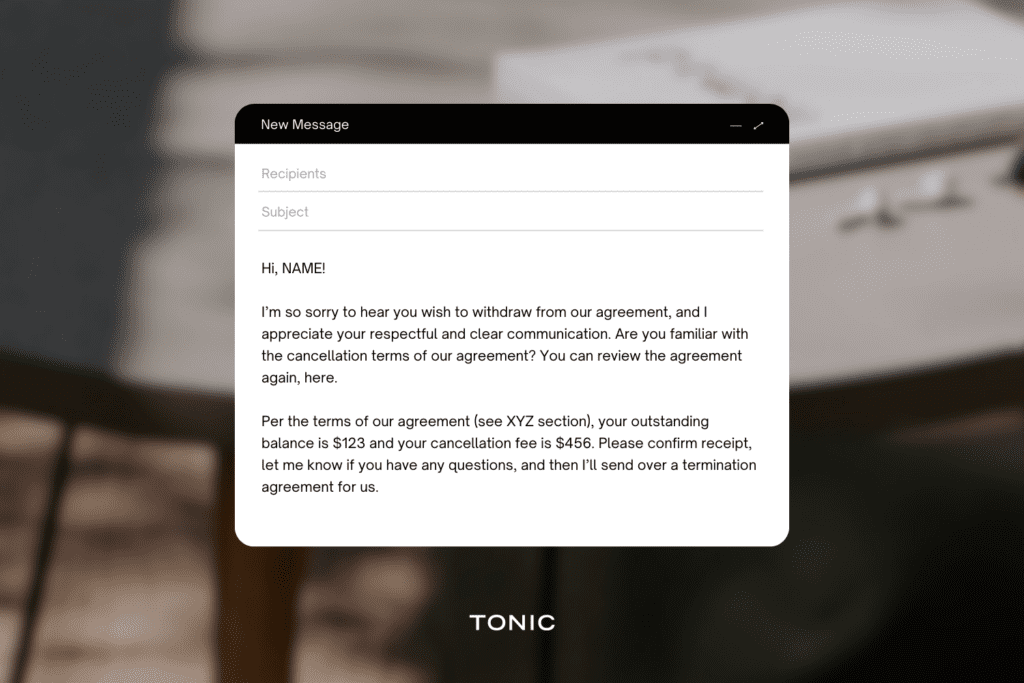
Step 2: Negotiate cancellation terms, if the situation warrants
Depending on the situation, you might be willing to negotiate a termination which is less strict than what your agreement states, which is entirely up to you as a business owner to decide. If you do choose to enter into this type of conversation in the interest of an amicable resolution, this is the point in the process to open the door to negotiation. Your contract is designed to protect you to the fullest extent — but you can always choose to waive certain terms or compromise, especially for the sake of your time and energy, at your discretion, of course.
You might also be faced with some back and forth with the client, for example, if they have questions about the termination terms, or any push back. It’s not uncommon, especially if the client never read the agreement in the first place, for them to express frustration with your terms. The client may even start communicating unprofessionally, using language that includes “unfair” or “I don’t see why…” or perhaps flat out refusing to pay. The conversation might escalate to the point of needing to get your attorney involved. Sometimes, you can prevent this by referring back to the agreement.
For example:
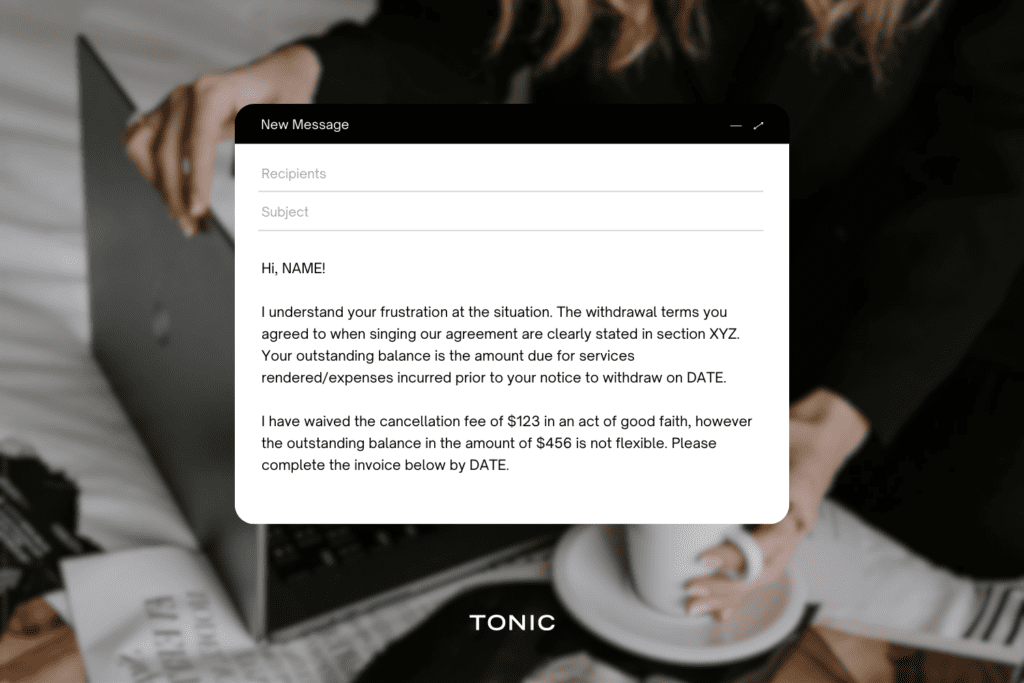
Step 3: Execute a termination agreement (we have one in The Artists’ Lawyer shop!) and accept payment
Whenever possible, execute a termination agreement. Not only does this provide a paper trail of the project termination, but it includes clauses which protect you from potential backlash from the client later on. Ensuring you’re paid for your work is important — but so is protecting your IP.
The termination agreement not only includes the amount due by the client at the time of termination, but it also indicates the terms both you and the client agree to when parting ways.
While email exchanges can serve as documentation, the safest way to release yourself and your client from the terms of the original contract is to sign a termination agreement.
As a Creative, You Need These Contract Terms in Place
If you’ve made it to this point in this post, you’re probably thinking, Well shoot, does my contract include everything it needs to in order for me to refer back to it in literally any situation that may come up?
It’s a good question — and one worth asking, for sure (even if it’s uncomfortable, or leaves you feeling exposed in the short term!).
For creative business owners, I find that the following clauses come up often in client disputes, so take a look at your agreement, and if any of these are not included, upgrade your contract by purchasing one from The Artists’ Lawyer shop.
- Project schedule
- Revisions and changes to deliverables
- Non-response
- Work style
- Timeliness
- Kill fee
- Cancellation by client
- Termination of agreement
- Limit of liability
Note: this is not an exhaustive list of the clauses that should be in your contract!
Most Important: Stay Calm
I get it, these situations can get real sticky, real quick — not to mention extremely stressful.
I always try to to step away from my computer before responding to a particularly rude email, so I can be impartial. If I ever tpe a response when I’m feeling heated, it’s always more emotional than productive. So, I take a deep breath, and wait to respond to the email until the next day, at least.
And remember, this is just one client’s opinion! Don’t take it personally — it’s business, after all. Less-than-ideal situations are bound to come up, and as a business owner you’ll unfortunately have to face them. I believe in you! And, I’m also here to help. Shop The Artists’ Lawyer contract template shop to make sure you’re starting from a strong foundation.
And if you’re in doubt, this blog post has some tips for vetting online contract templates and evaluating yours.
DISCLAIMER: This information is made available for educational and general informational purposes only; it is not legal advice for an individual case nor does it guarantee any future result. This material may be improved upon or updated without notice, and The Artists’ Lawyer will not be held responsible for any outcomes as a result of this education. Do not act upon this information without seeking individual advice from a lawyer licensed in your state. You understand that viewing this information does not establish an attorney-client relationship between you and The Artists’ Lawyer, or the founding attorney, Magi Fisher.
ABOUT THE AUTHOR

Magi Fisher, The Artists’ Lawyer, is a lawyer and educator for artists and creative entrepreneurs. Her journey has taken her from photographing professional surfers while swimming in some of the world’s most epic waves to receiving a Juris Doctorate from Rutgers Law. Magi founded Magdalena Studios, a boutique photography studio, which quickly grew, alongside her law career, to serve over 80 couples per year. Magi now oversees the wedding photography studio and team of associates, photographs a limited number of luxury and destination weddings per year, and provides legal counsel to creative business owners. Connect with Magi on Instagram @theartistlawyer or visit theartistslawyer.com.






